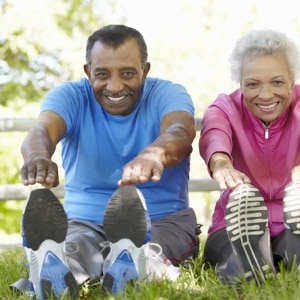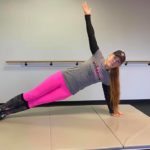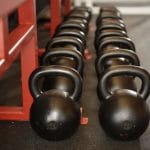In several other posts here, here, and here, I have discussed exercise and health science’s efforts to find the least amount of activity necessary to confer benefits. This goes back to my early years in grad school – 1978 to be exact – and the American College of Sports Medicine’s (ACSM) efforts to home in on what amount and type and intensity of exercise one needed to be aerobically fit.
A quick rundown of the changing data on this will be useful to the reader.
First, aerobics – an adaptation of the type of metabolic processes used by cells where oxygen is readily available to human endeavors – was promoted by Dr Kenneth Cooper in Texas. I have written about this pioneer here, here and here. Working with adults – mostly male – he came up with the idea, and this is a very blunt version of it, to refer to movement patterns at intensities below maximum that improve cardiovascular well-being. Over time, he and others determined that walking, jogging, cycling, swimming and other whole-body forms of ambulation above intensities of ~55% of maximal aerobic capacity (or MaxVO2) up to about 85% or so would improve health; maybe even extend longevity!
This early work from the late 1960s was then extended to the aerobics classes fads of the late 70s till the modern time, where other forms of body movements could be conglomerated to the point where heart rate (HR) would rise enough to qualify as ‘aerobic’. Thus, Jane Fonda et al. moved the needle into non-ambulatory exercises which, previously, had been considered ‘anaerobic’ – done without sufficient oxygen to be performed for long periods of time.
Stepping back, Cooper’s work initially settled on doing aerobics for 30 minutes at a minimum with 60 being ideal. This led to a jogging fad of 5K and 10K races which, at about 10 minutes/mile, amounted to the perfect exercise program for wellbeing.
But reality hit somewhere in the early 1980s, while I was headed toward my dissertation phase. There was this realization that many Americans simply were unwilling or unable to do that much exercise. ‘Lack of time’ became the fallback phrase for all those who could not commit to a regular exercise program.
Thus the search for the minimal amount of exercise one needs in order to achieve a level of fitness that would confer some health and longevity benefits. As a client of mine once asked of me, “Could you write up a de minimus routine for me?”
The other thing that happened in the later 80s and into the 90s was the realization that evidence now offered to show that resistance exercise, despite being inherently anaerobic – remember, without sufficient oxygen – could also yield cardiovascular and metabolic benefits. This segued into the current phase of fitness – HIIT, or high intensity interval training about which I’ve blogged here, here, here, here and here. Now, some creative fitness gurus figured, we could provide health and longevity benefits along with muscle strength and tone!
In addition to resistance training, the late 1990s brought to the foreground of fitness Tabatas – 4 minutes of very high intensity stationary bike training that yielded cardiovascular benefits, if done just twice a week, similar to traditional cardio workouts.
The race was on.
Many other research-based and popular-culture based mini-workouts, some using traditional cardio exercises, some using non-traditional cardio but very traditional strength exercises, have hit the marketplace of ideas this past decade or so. We have 12-minute, 7-minute, and even re-branded Tabatas as 3-minute workouts to get and stay fit. (The re-branded Tabatas essentially add the total time of work – 8 sets of 20 seconds, with 10-second rest periods – to come up with 160-seconds of exercise.)
Still, Americans, and all modern, industrial societies have become more sedentary. The entire science of sedentariness started to blossom even as these mini-HIIT workouts started. Aging populations and digital technologies contributed to the ever-present and increasing reduction in daily movement. We sit too much, even at work.
Hence the stand-up desk! I’ve written about these before, and was one of the early adopters for personal use, but not for fitness reasons: due to arthritic joints, it hurt to sit and stand frequently throughout the day – it was easier to stay standing!
Many articles have been published such as this one that reinforce the value and benefits of simply standing some of the day vs just sitting, making the stand-up desk a health-producing device, not simply a work station. Even though the actual calorie count of standing X-hours a day is not much, cumulatively it may add up to a 5.5# reduction in weight over a year’s time, according to a recent study in the European Journal of Preventive Cardiology (Jan. 31, 2018) as reported in the July issue of the Harvard Men’s Health Watch newsletter.
As part of the movement to help folks become more active, these desks and other admonitions to take standing or even better – walking – breaks from office or home sitting are a welcome weapon in the war against the ill effects of sedentary living.
But I fear they target the wrong folks – the ones who already know and care about their well-being, and are aware of these negative effects of our modern lifestyles. As much as exercise and medicine science promote movement, it seems it’s the same 20% +/- of the population who hears and abides by these recommendations. Most are Caucasian and younger, at least younger than 40, 45.
What can society – or even government – offer to the average non-Caucasian with a college degree and some measure of economic security and hope? And if government, in lieu of society, took the lead in this, what could it reasonably expect to accomplish, and at what cost?
Yesterday I read an article that demonstrated blacks slept less and worse than whites of the same age groups. Many reasons were posited, and many effects of reduced sleep were noted. The latter made sense – emotional and educational effects among them. The former, however, suggested measures akin to financial security, neighborhood safety, parental and cultural stability, etc.
Frustrated, as one who considers himself a progressive scientist – someone willing to study, take the results and try to implement policies to help as many people as possible -I found myself tuning out the authors’ recommendations. Too daunting.
Hell, if we can’t even get folks to stand up 2-5 minutes every hour while at work and at home to help them regulate blood pressure and blood sugar, what makes anyone think we can help underprivileged kids sleep safer and better?
Maybe all desks should be stand-ups and only if you have a true medical reason do you get a stool or chair for use with a sit-down computer.
















